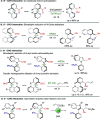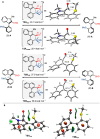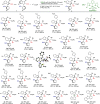Dynamic Kinetic Resolution of Indole-Based Sulfenylated Heterobiaryls by Rhodium-Catalyzed Atroposelective Reductive Aldol Reaction
- PMID: 37745194
- PMCID: PMC10513111
- DOI: 10.1021/acscatal.3c03422
Dynamic Kinetic Resolution of Indole-Based Sulfenylated Heterobiaryls by Rhodium-Catalyzed Atroposelective Reductive Aldol Reaction
Abstract
A highly enantio- and diastereoselective dynamic kinetic resolution (DKR) of configurationally labile 3-aryl indole-2-carbaldehydes is described. The DKR proceeds via a Rh-catalyzed intermolecular asymmetric reductive aldol reaction with acrylate esters, with simultaneous generation of three stereogenic elements. The strategy relies on the labilization of the stereogenic axis that takes place thanks to a transient Lewis acid-base interaction (LABI) between the formyl group and a thioether moiety strategically located at the ortho' position. The atropisomeric indole products present a high degree of functionalization and can be further converted to a series of axially chiral derivatives, thereby expanding their potential application in drug discovery and asymmetric catalysis.
© 2023 The Authors. Published by American Chemical Society.
Conflict of interest statement
The authors declare no competing financial interest.
Figures





Similar articles
-
Catalytic Atroposelective Synthesis of C-N Axially Chiral Aminophosphines via Dynamic Kinetic Resolution.Angew Chem Int Ed Engl. 2024 Sep 9;63(37):e202409524. doi: 10.1002/anie.202409524. Epub 2024 Aug 12. Angew Chem Int Ed Engl. 2024. PMID: 38923738
-
Dynamic Kinetic Resolution of Heterobiaryl Ketones by Zinc-Catalyzed Asymmetric Hydrosilylation.Angew Chem Int Ed Engl. 2018 Mar 26;57(14):3777-3781. doi: 10.1002/anie.201713200. Epub 2018 Mar 6. Angew Chem Int Ed Engl. 2018. PMID: 29437283
-
Nickel-Catalyzed Dynamic Kinetic Asymmetric Reductive Arylation of Aldehydes with Heterobiaryl Triflates.Org Lett. 2025 Mar 28;27(12):2897-2901. doi: 10.1021/acs.orglett.5c00441. Epub 2025 Mar 15. Org Lett. 2025. PMID: 40088182
-
Atroposelective Synthesis of Heterobiaryls through Ring Formation.Chemistry. 2023 May 11;29(27):e202300183. doi: 10.1002/chem.202300183. Epub 2023 Apr 4. Chemistry. 2023. PMID: 36872611 Review.
-
Diastereo- and enantioselective anti-selective hydrogenation of α-amino-β-keto ester hydrochlorides and related compounds using transition-metal-chiral-bisphosphine catalysts.Chem Rec. 2014 Apr;14(2):235-50. doi: 10.1002/tcr.201300032. Epub 2014 Feb 18. Chem Rec. 2014. PMID: 24550034 Review.
Cited by
-
Atroposelective catalysis.Nat Rev Chem. 2024 Jul;8(7):497-517. doi: 10.1038/s41570-024-00618-x. Epub 2024 Jun 18. Nat Rev Chem. 2024. PMID: 38890539 Review.
-
Catalytic Asymmetric Diastereodivergent Synthesis of 2-Alkenylindoles Bearing both Axial and Central Chirality.Precis Chem. 2024 Apr 23;2(5):208-220. doi: 10.1021/prechem.4c00008. eCollection 2024 May 27. Precis Chem. 2024. PMID: 39474410 Free PMC article.
-
Rhodium-Catalyzed Asymmetric Synthesis of 1,2-Disubstituted Allylic Fluorides.Angew Chem Int Ed Engl. 2023 Nov 27;62(48):e202314843. doi: 10.1002/anie.202314843. Epub 2023 Oct 27. Angew Chem Int Ed Engl. 2023. PMID: 37856668 Free PMC article.
-
Chemoenzymatic Dynamic Kinetic Resolution of Atropoisomeric 2-(Quinolin-8-yl)benzylalcohols.J Org Chem. 2025 Apr 18;90(15):5120-5124. doi: 10.1021/acs.joc.4c02996. Epub 2025 Apr 9. J Org Chem. 2025. PMID: 40203203 Free PMC article.
-
Bifunctional Squaramide-Catalyzed Oxidative Kinetic Resolution: Simultaneous Access to Axially Chiral Thioether and Sulfoxide.Adv Sci (Weinh). 2024 Jul;11(28):e2402429. doi: 10.1002/advs.202402429. Epub 2024 May 15. Adv Sci (Weinh). 2024. PMID: 38751149 Free PMC article.
References
-
- Toenjes S. T.; Gustafson J. L. Atropisomerism in Medicinal Chemistry: Challenges and Opportunities. Future Med. Chem. 2018, 10, 409–422. 10.4155/fmc-2017-0152. - DOI - PMC - PubMed
- Clayden J.; Moran W. J.; Edwards P. J.; LaPlante S. R. The Challenge of Atropisomerism in Drug Discovery. Angew. Chem., Int. Ed. 2009, 48, 6398–6401. 10.1002/anie.200901719. - DOI - PubMed
- Smyth J. E.; Butler N. M.; Keller P. A. A Twist of Nature-The Significance of Atropisomers in Biological Systems. Nat. Prod. Rep. 2015, 32, 1562–1583. 10.1039/C4NP00121D. - DOI - PubMed
-
- Dotsevi G.; Sogah Y.; Cram D. J. Total Chromatographic Optical Resolution of α-Amino Acid and Ester Salts through Chiral Recognition by a Host Covalently Bound to Polystyrene Resin. J. Am. Chem. Soc. 1976, 98, 3038–3041. 10.1021/ja00426a073. - DOI - PubMed
- Takaishi K.; Yasui M.; Ema T. Binaphthyl-Bipyridyl Cyclic Dyads as a Chiroptical Switch. J. Am. Chem. Soc. 2018, 140, 5334–5338. 10.1021/jacs.8b01860. - DOI - PubMed
- Li Q.; Green L.; Venkataraman N.; Shiyanovskaya I.; Khan A.; Urbas A.; Doane J. W. Reversible Photoswitchable Axially Chiral Dopants with High Helical Twisting Power. J. Am. Chem. Soc. 2007, 129, 12908–12909. 10.1021/ja0747573. - DOI - PubMed
-
- Privileged Chiral Ligands and Catalysts; Zhou Q.-L., Ed.; Wiley-VCH: Weinheim, Germany, 2011.
- Li Y.-M.; Kwong F.-Y.; Yu W.-Y.; Chan A. S.C. Recent Advances in Developing New Axially Chiral Phosphine Ligands for Asymmetric Catalysis. Coord. Chem. Rev. 2007, 251, 2119.10.1016/j.ccr.2007.07.020. - DOI
- Chen Y.; Yekta S.; Yudin A. K. Modified BINOL Ligands in Asymmetric Catalysis. Chem. Rev. 2003, 103, 3155.10.1021/cr020025b. - DOI - PubMed
-
- Parmar D.; Sugiono E.; Raja S.; Rueping M. Complete Field Guide to Asymmetric BINOL-Phosphate Derived Brønsted Acid and Metal Catalysis: History and Classification by Mode of Activation; Brønsted Acidity, Hydrogen Bonding, Ion Pairing, and Metal Phosphates. Chem. Rev. 2014, 114, 9047.10.1021/cr5001496. - DOI - PubMed
- Min C.; Seidel D. Asymmetric Brønsted Acid Catalysis with Chiral Carboxylic Acids. Chem. Soc. Rev. 2017, 46, 5889.10.1039/C6CS00239K. - DOI - PubMed
LinkOut - more resources
Full Text Sources
